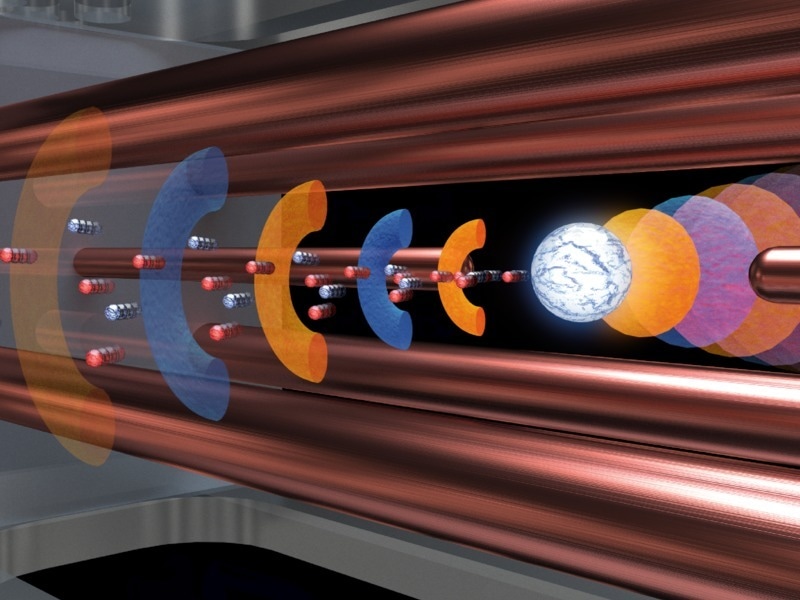Feb 1 2018
Physicists from LMU Munich have guided a group of researchers to achieve an important breakthrough in laser-driven particle acceleration. The team used tiny plastic beads as targets to produce proton bunches that have distinctive characteristics, thereby opening up new prospects for future research work.
 Artist’s impression of the laser-plasma interaction: the laser beam approaches the electrodynamic particle trap from the left and impinges on the levitated plastic microsphere, accelerating the bunch of electrons and protons. (Image credit: Marcel Menke)
Artist’s impression of the laser-plasma interaction: the laser beam approaches the electrodynamic particle trap from the left and impinges on the levitated plastic microsphere, accelerating the bunch of electrons and protons. (Image credit: Marcel Menke)
During the experiments, the team directed a powerful laser pulse at a micrometer-sized plastic sphere, blasting a cluster of protons from the target and increasing their velocities to be nearer to the speed of light. The ensuing velocity distribution is considerably narrow when compared to the one achieved upon using thin metal foils as targets.
There have been significant breakthroughs recently in devising an innovative strategy for accelerating subatomic particles. This approach involves using intense electric fields intrinsic to high-energy, pulsed laser beams, to increase the speed of protons and electrons to “relativistic” velocities, that is, speeds close to that of light. Laser-driven acceleration of protons is a stepping stone for developing compact particle accelerators. Earlier, the laser shot has usually been targeted at a thin metal foil, synthesizing and accelerating a plasma of free electrons and positively charged ions. At present, physicists from the Ludwig-Maximilians-Universität (LMU) in Munich have substituted the foil target with a plastic microsphere that has a diameter of one-millionth of a 1 m. The size of the beads is so small that it is not easy to stably position them by mechanical processes. In contrast, the target particle was levitated by applying an electric field. The levitated bead can be confined with adequate accuracy by using a feedback circuit. This is done to make sure that it does not drift off the beam axis. The electromagnetic trap was designed and developed at the Department of Medical Physics at LMU.
The experiments were performed in cooperation with scientists from the Max Planck Institute of Quantum Optics, the Helmholtz-Zentrum in Dresden-Rossendorf, the GSI Helmholtzzentrum für Schwerionenforschung (Centre for Heavy-Ion Research) in Darmstadt, the TU Darmstadt, the TU Dresden, Goethe University in Frankfurt am Main, and the Helmholtz Institute, Jena.
Bursting a proton cluster from such a plastic microsphere necessitates exceptionally robust and effective laser systems. The PHELIX laser in Darmstadt, used to perform the experiments, has the needed specifications and has the potential to produce laser pulses lasting for 500 fs, where 1 fs is equal to one-millionth of one-billionth of 1 s, and convey 150 J of energy, the amount required to shoot an apple to an altitude of 75 m.
The laser energy is concentrated on a region that has a diameter proportional to the width of a strand of human hair. The power density thus accomplished is analogous to the deposition of the total energy produced across the globe in one year on an area of 1 cm2. The specific geometry of the microsphere target chosen for these experiments is such that the impact of the laser beam generates a plasma, the characteristics of which will be nearly improbable to simulate by striking a foil target.
Traditional laser-powered proton acceleration leads to the formation of proton clusters with an exponential velocity distribution, that is, the speed of majority of the particles is increased to comparatively low velocities and lesser particles are liberated from the target at the highest speeds. The proton clusters produced in this research are highly distinctive due to this reason: their energy spread is very narrow, or majority of the particles display very similar velocities. Such a behavior is largely atypical for laser-driven proton beams, and it is highly important for prospective applications of the new strategy.
Along with the experimental study, the researchers also performed simulations of the dynamics of the proton plasma using the TITAN supercomputer. The outcomes indicate that a characteristic proton cluster includes about 14% of the protons that existed in the original spherical target. This indicates that the speed of a considerable fraction of the plastic sphere is increased in a directional and compact manner under these conditions. In addition, the simulations also indicate that only a small portion of the energy distributed by the laser is really conveyed to the protons, in turn indicating that there is more scope of enhancement.
The fundamental strategy is equivalent to collisions between billiard balls. “In our experiment, one of the balls is made of light and the other is our tiny levitated target,” explained Peter Hilz, who headed the experiments. This innovative strategy for producing proton beams will render improbable experiments possible. “In the coming years, we will concentrate on optimizing the new acceleration process with the help of further simulations and experiments,” added Hilz.
Prospective future applications include materials science, fusion research, and cancer treatment. The proton clusters produced by adopting the new method would also be of interest for research work in fundamental physics. For instance, they could enable to recreation of states of matter seen in the inner part of the Sun or in the inner recesses of huge planets such as Saturn and Jupiter at the laboratory scale.